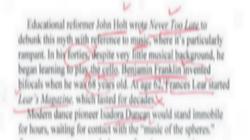Become a Freelance Science Writer
Who Easily Gets Assignments (or a Science Blogger Who
Collects "Likes" by the Thousands)
by Marcia Yudkin
According to the Council for the Advancement of Science Writing, "By far the most important qualities needed by a prospective science writer are a fascination with science and a talent for writing clearly, accurately and with an interesting flair."
I recently spent some time in my library's periodical room finding examples of articles that illustrate the last quality mentioned there: writing flair. Here are some techniques skillful science writers use to make challenging intellectual material come alive with human interest and drama.
The techniques described below apply equally to science
writing on blogs and websites, of course.
|
When writing on physics, biology, astronomy or some other science, you're often in the position of having to educate readers. Yet you don't want to make your article read like a textbook or term paper. Let's take the issue of whether or not Einstein was right in claiming that nothing can ever go faster than the speed of light, and how writer David H. Freeman covered it in a highly engaging article, "Faster than a Speeding Photon," published in
Discover magazine.
Find the human element. Freeman approached the topic through mini-profiles of four maverick scientists trying to prove Einstein wrong. We meet them one by one and get to know exactly how each is trying differently from one another to overturn relativity theory. Each scientist comes off as a quirky, quixotic character.
|
|
Published! How to
Reach Writing Success
|
|
Describe the people involved and their working environments. The physical appearance, manner, office and in some cases hobbies of each scientist are vividly described. They come across as complete individuals who have three-dimensional lives.
Hook the reader through irony and description.
The article opens by introducing the reader to a man who is trying to make it as a country music songwriter, and by day trying to disprove Einstein's theory of relativity. Such an odd combination which closes the article as well compels attention.
Use interesting characterizations. Just a tiny selection of the stimulating phrases found in this ten-page article:
"His expression suggests that he is at once irrepressibly hopeful and perpetually braced for disappointment. His desk suggests a passion for organization that borders on the pathological."
"But Millis has managed to use his modest resources to become a sort of Oprah of faster-than-light travel."
"An owlish professor with 20 years of service, he has a philosopher's habit of staring into the distance for several moments before answering a question."
"Unfortunately, those credentials may not provide quite enough air cover for
Haisch."
|
Become a Successful Freelance
Writer - Start Today!
Slash your learning curve by completing nine
article idea generation and writing assignments
and gaining feedback from a Book-of-the-Month Club
author who has published in the New York Times
Magazine, Business
2.0, Psychology Today, USAirways, TWA Ambassador
and many other top publications. Magazine
writing course for beginners. |
Get to the theory only after hooking the reader.
Details of each scientist's theory are sandwiched between portrayals of the scientist as a many-dimensional person in a specific work setting.
Explain abstruse ideas slowly, carefully and with metaphors. Freedman gets across the idea of a "wormhole" by simplifying four dimensions to two and asking us to imagine the universe as being as flat as paper and as stretchy as rubber. Later in the article, he uses a whole magazine page to take the reader step by step through the assumptions and procedures of an important experiment.
Another much shorter article in Discover describes the work of a Pennsylvania physics professor who also teaches and studies ballet. Here are a few techniques that writer, Robert
Kunzig, used in addition to some of those used by Freeman:
|
Ready for the World's Top
Science Assignments?
If you have impressive clips and a track
record writing science stories but can't crack
top markets, you need the advanced
"Breaking Into Major Magazines"
course. Discover the factors that make the
difference between just-okay, publishable
writing and the kind that gets published in Smithsonian,
National Geographic, Popular Science and other glossies.
Advanced magazine
writing course. |
Scenes. We see the physics professor interacting with ballet students in a nicely described scene, complete with dialogue.
Dual perspectives. Throughout the article, the writer plays off two ways of viewing the same scene as a ballet aficionado would see it (in terms of grand jetes and arabesques and as a physicist analyzing the forces of motion would see it in terms of torque and momentum.
Problem/solution. The piece ends with a nice scene in which a young dancer agrees to try something that the professor believes should work, according to his knowledge of physics. It does work, and produces a satisfying sense of closure for the reader as well.
In Popular Science, writer Mark D. Uehling used one more technique in his article on antibiotic-resistant bacteria that you'll want to have in your repertoire when you write about phenomena that can't be directly seen.
An organizing metaphor. From beginning to end, the scientists' actions and goals are characterized by one consistent metaphor, counterintelligence warfare. This does not descend to a clichι because each instance of the metaphor contains original twists:
"A high-tech command post is gathering intelligence for a counterattack."
"Gary Doern, Sentry's microbiologist, takes watching the bugs as seriously as CIA spies took monitoring the Russians during the Cold War."
"This time, at least, a bug's victory on the battlefield has been promptly noted, and physicians fighting Moraxella can now start to plan their counterattack."
Master these ten techniques, and you'll be able to turn your fascination with science and talent for clear, accurate writing into a prosperous freelance career.
Copyright 2001, 2007 Marcia Yudkin. All rights reserved.
|






